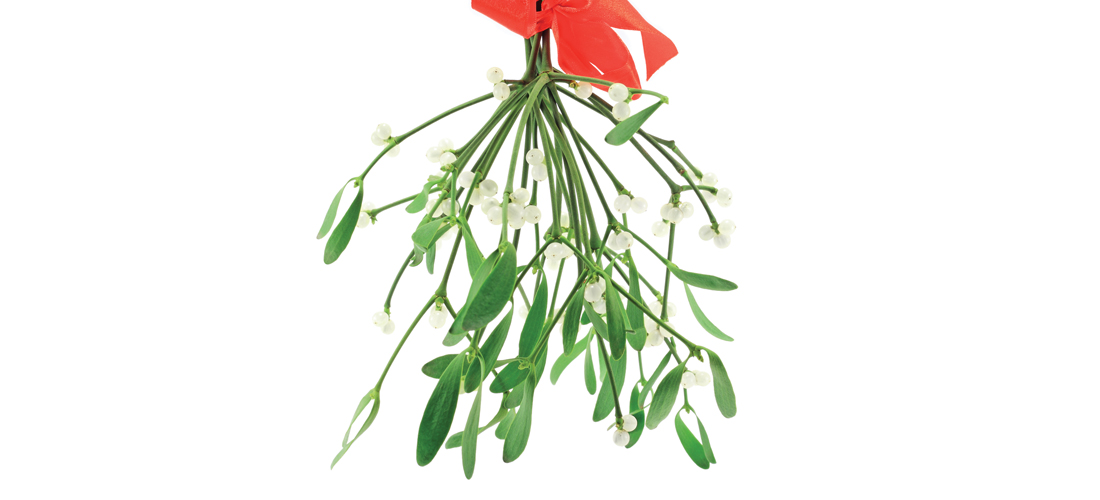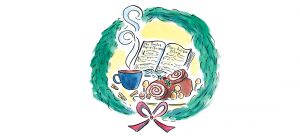
A Magical Plant
When life hangs in the balance, hang some mistletoe
By Ross Howell Jr.
The more I write about plants, the better I see how we humans are compelled to invest them with meaning.
Consider mistletoe. Practically all of Western civilization hangs on its evergreen, parasitic little branches.
Escaping Troy’s annihilation by invading Greeks, Aeneas would be named the ancestor of Rome by the poet Virgil. Along the way, Aeneas used mistletoe, the “golden bough,” to light his way “through a vast and gloomy forest” to the river Styx, according to Professor Frank H. Tainter. There, he shows the bough to the ferryman, Charon, and “both were immediately transported to the nether world.”
Says Professor Tainter, “Such was the power of the mistletoe plant!”
The ancient Celts viewed it as a fertility plant; the Druids as a magical cure for most anything. This pagan primal power was translated delicately into a Christmas kissing tradition in 18th-century England. And that’s how most of us think of the plant today.
Shirley Broome remembers her mother — known as “Mom” to Greensboro Farmers Curb Market goers — having two big maples in front of her house. The maples were dying and loaded with mistletoe, but they were her mother’s favorite trees. Finally she agreed to have one felled.
“Some of the branches of mistletoe were as thick as my thumb,” Shirley says. “We left part of the maple limb attached, so customers could see how the mistletoe grew into the bark.
“People were surprised at the size of the clusters! I had one bunch that must’ve been 12 inches in diameter.”
Did Mom ever hang a sprig of mistletoe in her own house?
“Goodness, no,” Shirley says. “We didn’t have time for that!”
For O.Henry Contributing Editor David Bailey, gathering mistletoe meant getting to fire his father’s 12-gauge shotgun. Near Reidsville, “We’d head to an old home site where there were several massive oaks,” David says. “There’d be a nip in the air and to this day whenever it starts to get cold, I recall the acrid scent of cordite.”
David’s father loaded No. 8 shells, small shot used for dove or quail. For a 6-year-old boy, aiming accurately enough to bring down mistletoe from a towering oak wasn’t easy.
“Two or three shots would leave my shoulder bruised, but I was ecstatic,” David says. “We’d usually get a third of a bushel basketful to take to neighbors and friends.”
“Mom would’ve whipped up eggnog by the time we got home and I was allowed just a whiff of nog,” David continues. “Good memories, even if my sister planted a big old, sloppy wet smooch on me under the mistletoe.”
Some of his wife’s earliest memories of Christmas revolve around the search for mistletoe. “My mother’s younger sister Hope was in high school then and dating, so of course mistletoe hanging from the doorways was essential,” Anne says. “The urgency of procuring the stuff, and the ritual of gathering it, made it plain to me that mistletoe was a magical plant.”
As her father drove down woodland dirt roads of South Carolina’s Lowcountry, her mother, aunt and Anne would search the tall trees. Once they’d spotted a fine growth, “Dad would park the car, get his gun and shells from the trunk, and confer with Mom and Hope,” Anne remembers. “Which bunch was fullest? Which least obscured by intervening branches?”
With all the input from her mother and aunt, and her own squeals added into the equation, “It could take almost an hour to get down to the nub of gathering mistletoe,” Anne says.
“At last Dad would take aim, and after the blast the air under the tree was filled with a snowfall of small green clusters, peppered with waxy white berries,” Anne continues. “We’d retrieve the fullest twigs and pile them into a box in the trunk of Dad’s Ford. Dad was a good shot and he’d always bring down a few more clumps, just in case we ran out, I suppose.”
O.Henry’s editor Jim Dodson says his earliest memory of mistletoe dates back to seventh grade, when his mother asked his father to collect mistletoe for the Christmas holiday.
“Dad loaded my brother and me in the car along with a shotgun and we headed out Buckhorn Road near Mebane,” Jim says.
Driving on what was then a country road, “We turned into an overgrown sideroad and hiked half a mile into an oak forest to an abandoned house with giant oak trees out front,” Jim adds. “Those trees were loaded with mistletoe.” This was the spot, his father informed the boys, where their great-grandfather, “Jimmy” Dodson, had grown up. Nearby was the house where their great-grandmother, Emma Tate Dodson, had been raised.
Both the Dodsons and the Tates had journeyed to North Carolina on what Jim’s father called the “Great Road,” or “Great Wagon Road,” the path that many Scots-Irish immigrants followed in search of places to settle in their new country.
“We blasted away with the shotgun,” Jim continues. “I remember we had so much mistletoe we loaded it in a cardboard box.” On the way back, they hiked to a spot on the Haw River, where the Dodsons had operated a gristmill in the early 19th century.
“That was the first time I remember my father sharing with us a sense of family history,” Jim says. “The idea of the Great Wagon Road really caught my imagination.”
With more than enough mistletoe to satisfy their mother’s request, they took what remained to the Lutheran Church. And you can read about the Great Wagon Road when Jim completes his current book on the historical road.
See? Quite a bit still depends on a branch of mistletoe. OH
Ross Howell Jr. is circulating a collection of short stories to various publishers. Please wish him luck.





